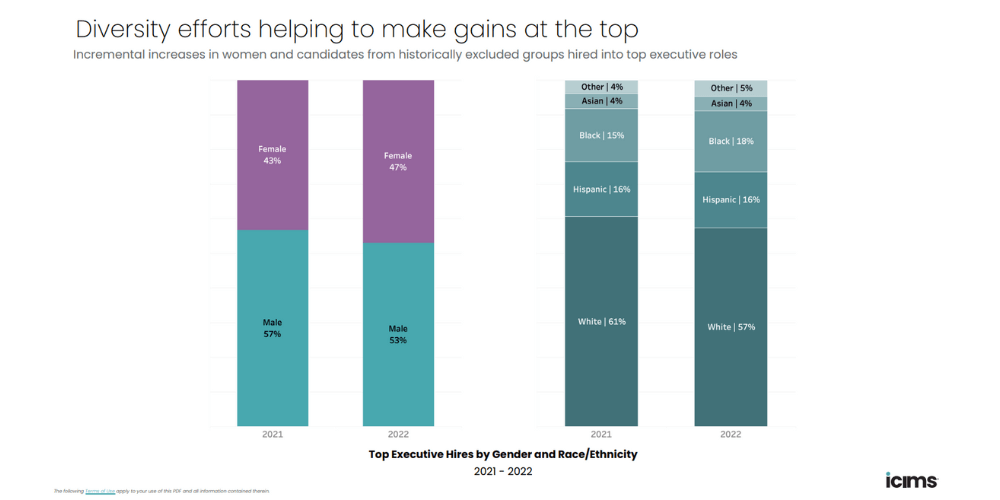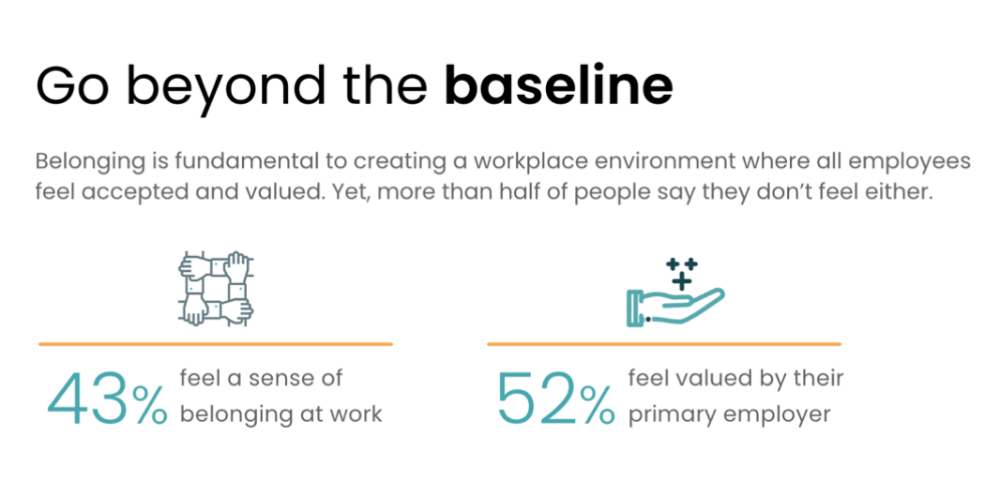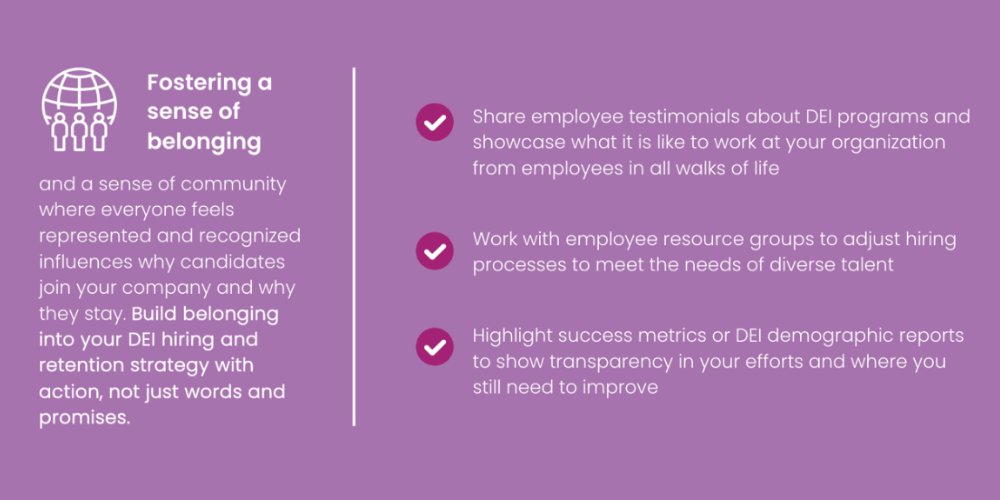- Solutions
- Products
- Community
- Resources
- Company
Create incredible candidate experiences that communicate your brand, mission, and values with recruitment marketing solutions.
Learn moreCommunicate effectively and efficiently with the candidates that can drive your business forward.
Learn moreSelect the right candidates to drive your business forward and simplify how you build winning, diverse teams.
Learn moreHelp your best internal talent connect to better opportunities and see new potential across your entire organisation.
Learn moreCommunicate collectively with large groups of candidates and effectively tackle surges in hiring capacity.
Learn moreAccess tools that help your team create a more inclusive culture and propel your DEI program forward.
Learn moreRebound and respond to the new normal of retail with hiring systems that are agile enough to help you forge ahead.
Learn moreAccelerate the hiring of key talent to deliver point of care and support services that meet and exceed your promise of patient satisfaction.
Learn moreAttract and engage candidates with technical competencies, accelerate hiring for much-needed skills, and advance expertise within your valued workforce.
Learn moreSimplify how you recruit finance, insurance, and banking candidates with a unified platform built to match top talent with hard-to-fill roles.
Learn moreYour business strategy depends on your people strategy. Keep both in lockstep with the iCIMS Talent Cloud.
Learn moreBuild an engaging, high-converting talent pipeline that moves your business forward.
Learn moreDeliver the innovation your talent team needs, along with the global scale and security you demand.
Learn moreDeliver tailored technology experiences that delight users and power your talent transformation with the iCIMS Talent Cloud.
Learn moreThe #1 ATS in market share, our cloud-based recruiting software is built for both commercial and large, global employers.
Learn more Talk to salesAttract the best talent for your business with powerful, on-brand career websites that excite candidates and drive engagement.
Learn more Talk to salesCombine behavior-based marketing automation with AI insights to build talent pipelines, engage candidates with multi-channel marketing campaigns, and automatically surface the right talent for the job.
Learn more Talk to salesEmpower candidates with automated self-service, qualification screening, and interview scheduling through an AI-enabled digital assistant.
Learn more Talk to salesSimplify employee onboarding with automated processes that maximize engagement and accelerate productivity.
Learn more Talk to salesRecruit in the modern world and expand your reach with built-in virtual interviewing.
Learn more Talk to SalesFocus on qualifying candidates faster with fully integrated language assessments.
Learn more Talk to SalesImprove employee experience, retention, and reduce internal talent mobility friction with the iCIMS Opportunity Marketplace.
Learn more Talk to salesCompliment your sourcing and engagement efforts with sophisticated lead scoring and advanced campaign personalization.
Learn more Talk to salesModernize, streamline, and accelerate your communication with candidates and employees.
Learn more Talk to salesTransform the talent experience by showcasing your authentic employer brand through employee-generated video testimonials.
Learn more Talk to salesGive your business a competitive edge with a complete solution for creating personalized, timely, and accurate digital offer letters that inspire candidates to want to join your team.
Learn more Talk to SalesSimplify recruiting, dynamically engage talent, and reduce hiring bias with job matching and recruiting chatbot technology.
Learn more Talk to salesThe #1 ATS in market share, our cloud-based recruiting software is built for both commercial and large, global employers.
Learn more Talk to salesAttract the best talent for your business with powerful, on-brand career websites that excite candidates and drive engagement.
Learn more Talk to salesCombine behavior-based marketing automation with AI insights to build talent pipelines, engage candidates with multi-channel marketing campaigns, and automatically surface the right talent for the job.
Learn more Talk to salesEmpower candidates with automated self-service, qualification screening, and interview scheduling through an AI-enabled digital assistant.
Learn more Talk to salesSimplify employee onboarding with automated processes that maximize engagement and accelerate productivity.
Learn more Talk to salesCompliment your sourcing and engagement efforts with award-winning lead scoring and advanced campaign personalization.
Learn moreImprove employee experience, retention, and reduce internal talent mobility friction with the iCIMS Opportunity Marketplace.
Learn more Talk to salesModernise, streamline, and accelerate your communication with candidates and personnel.
Learn more Talk to salesTransform the talent experience by showcasing your authentic employer brand through employee-generated video testimonials.
Learn more Talk to salesSimplify recruiting, dynamically engage talent, and reduce hiring bias with job matching and recruiting chatbot technology.
Learn more Talk to salesHow PRMG attracts 50% more applicants for niche finance roles with the iCIMS Talent Cloud.
Learn moreThousands strong, our global community of talent professionals includes creatives, innovators, visionaries, and experts.
Learn moreTogether we’re creating the world’s largest ecosystem of integrated recruiting technologies.
Learn morePartner with our global professional services team to develop a winning strategy, build your team and manage change.
Learn moreExplore our network of more than 300 certified, trusted third-party service and advisory partners.
Learn moreExpert guidance about recruitment solutions, changes in the industry, and the future of talent.
Learn moreExpert guidance about recruitment solutions, changes in the industry, and the future of talent.
Learn moreStay up to date with the latest terminology and verbiage in the HR software ecosystem.
Learn morePartner with iCIMS to build the right strategies, processes, and experience to build a winning workforce.
Learn moreThe iCIMS Talent Cloud delivers a secure, agile, and compliant platform designed to empower talent teams, job seekers, and partners with advanced data protection and privacy.
Learn moreWatch the recording of our latest webinar looking at key findings from a recent study and explore short-term and long-term solutions for the talent crisis in 2022 and beyond.
Watch on-demandView press releases, media coverage, and the latest hiring data. See what analysts are saying about iCIMS.
Learn moreiCIMS is the Talent Cloud company that empowers organizations to attract, engage, hire, and advance the talent that builds a winning workforce.
Learn moreGet to know the award-winning leadership team shaping the future of the recruiting software industry.
Learn moreWe believe the future of work isn't something that "happens" to you. It's something you create. We actively create the future of work with our customers every day.
Learn moreStreamline your tech stack and take advantage of a better user experience and stronger data governance with ADP and the iCIMS Talent Cloud.
Learn moreThe combined power of iCIMS and Infor helps organizations strategically align their business and talent objectives.
Learn moreOur award-winning partnership with Microsoft is grounded in a shared desire to transform the workplace and the hiring team experience.
Learn moreOur partnership with Ultimate Kronos Group (UKG) supports the entire talent lifecycle by bringing frictionless recruiting solutions to UKG Pro Onboarding.
Learn moreLet’s get in touch. Reach out to learn more about iCIMS products and services.
Learn more
Google “importance of belonging,” and you’ll quickly discover how critical it is for humans to feel connected to others. According to psychologist Abraham Maslow — whose hierarchy of needs maps out five levels of human essentials, starting with the most basic — belonging is not far above food and shelter and on the same plane as love.
But in the modern world of work, creating environments that foster that feeling of belonging and inclusion is often paid a lot of lip service but never put into action. Instead, a company might say it has a diversity, equity and inclusion (DEI) strategy and is committed to nurturing an inclusive workplace but fails to source more diverse candidates for leadership positions.
“It’s one thing to have representation at the entry-level positions, or to say that 20% of your intern class is from historically excluded groups (HEGs),” said Chinor Lee, director of DEI at iCIMS. “But it’s another when diversity higher up the hierarchy — like front-line managers or the people who are setting and executing the strategy of the organization — completely falls off the cliff.”
Lee went on to say that candidates will see the depth of an organization’s commitment to creating a diverse workforce when they show up for an interview, and nobody looks like them. The goal is to build strong, trusting relationships with candidates from HEGs with actions, not just words and promises. Candidates can see right through inauthentic messages that aren’t backed up by concrete action.
In our 2023 Workforce Report, nearly two-thirds (59%) of people ranked their company’s DEI initiatives as effective, yet most respondents don’t see DEI practices in place at work (such as pronouns, celebrations of different cultures, unconscious bias training or allyship programs). While belonging is fundamental at work, more than half of our survey’s respondents said they don’t feel either, with only 43% feeling a sense of belonging at work and 52% feeling valued by their primary employer.

The absence of these practices — perhaps perceived as critical indicators of true inclusion — may be keeping some organizations from doing anything more than just scratching the DEI surface.
Don’t get us wrong: there’s been progress in workplace diversity in the last few years. In fact, diversity efforts may be helping to make recent gains at the top levels, according to a recent iCIMS survey, with incremental increases in women and HEG candidates hired into top executive roles. Notably, the share of women and black professionals has seen an uptick, with 4% and 3% YoY increases, respectively.
Today’s millennial and Gen Z workforce consider diverse and equitable hiring practices to be the bare minimum. In a hypercompetitive landscape, corporations realize that DEI isn’t just good ethics or even good PR. It’s simply good business. Research has shown that companies are 21% more likely to outperform their goals with more profitability when they have greater gender diversity on their teams.

DEI is also a clear path to the engagement and retention necessary to build a strong, productive workforce, especially in an uncertain labor market. Studies have shown that organizations with diverse, inclusive workforces win. According to Deloitte, diverse organizations are 3.1 times more likely to adapt to change effectively and 2.6 times more likely to engage and retain their employees.
DEI should be regarded not as just one more task on recruiters’ plates but as a tool to help them navigate the challenging new hiring landscape. Let’s dig into how it’s done.
Okay, so we’ve made a compelling argument that DEI is not only a critical ingredient in your overall hiring strategy but needs to be baked into your company culture. So, what now? How can you improve our efforts?
We looked at how some of our customers are creating inclusive workplaces at different stages of the talent lifecycle.
To level the interviewing playing field, the talent team at Celanese, a global manufacturer, sends out a welcome video explaining what to expect during the process. Understanding how stressful the interview process can be, this approach not only helps minimize anxiety for HEG candidates but provides more opportunities for diverse talent to succeed and advance their careers.
Spectrum, the leading broadband and cable operator, is committed to getting military veterans back into the civilian workforce. The talent team uses employee-generated videos to let members of its veteran workforce talk about their experiences transitioning to civilian life. Those videos personalize the talent experience and provide transparency into what it’s like for a veteran to work for the company.
Leaders understand that the future of their business depends on creating a diverse workforce and that they must build more DEI-focused talent journeys as a result.

Setting aside all the numbers, how do you know if your efforts to create an inclusive environment are working? How do you quantify whether an employee feels like they belong with their team at your company?
“The challenging thing about belonging is that it can vary — by day, project and moment,” Lee said. Rather than relying on annual or semiannual engagement surveys, which capture where employees are at one particular moment and might change the next day, some companies are turning to pulse surveys for a quick check-in.
British retailer Marks and Spencer performs three pulse surveys each year that help managers and their teams measure employee engagement and adjust based on feedback. Tech giant, Microsoft, reported that the company conducts daily surveys of random sampling of employees about the company’s return-to-office plans to hear firsthand from employees what is and isn’t working.
No matter the approach, think of your DEI initiatives as a combined holistic process that ensures HR can source talent from a diverse pool of candidates, foster an environment for them to succeed and then support them through prolonged tenure at the organization. To do that, you need to get out of the DEI kiddie pool and jump into the deep end.

Amy brings a knack for storytelling and strategy to her role at iCIMS. A longtime journalist and marketing consultant, she is on a mission to make her content sparkle with details and clarity.
As an essayist, Amy’s writing has appeared in The Washington Post and Family Circle magazine. When not writing, you can find her going for long hikes in the woods with her goldendoodle, working in her veggie garden or researching her next travel destination – which has included spots like Hong Kong, the Greek islands and Newfoundland.




